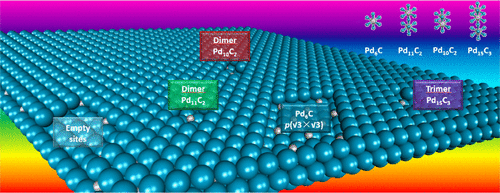当前位置:
X-MOL 学术
›
J. Phys. Chem. C
›
论文详情
Our official English website, www.x-mol.net, welcomes your
feedback! (Note: you will need to create a separate account there.)
Equilibrium Distribution of Dissolved Carbon in PdCx: Density Functional Theory and Canonical Monte Carlo Simulations
The Journal of Physical Chemistry C ( IF 3.3 ) Pub Date : 2021-09-17 , DOI: 10.1021/acs.jpcc.1c06682 Yucheng He 1 , Chao Wu 1
The Journal of Physical Chemistry C ( IF 3.3 ) Pub Date : 2021-09-17 , DOI: 10.1021/acs.jpcc.1c06682 Yucheng He 1 , Chao Wu 1
Affiliation

|
Subsurface carbon in Pd-based catalysts plays a key role in the selectivity of hydrogenation reactions. The existing model for subsurface carbon distribution (uniform Pd6C) in Pd inadequately interprets the structure of all as-prepared PdCx catalysts. Additionally, compared with neighboring element boron and nitrogen forming PdA0.5 (A = B or N) alloys, the carbon concentration in Pd is fairly low (usually PdC0.13). Utilizing density functional theory calculations combined with Canonical Monte Carlo (CMC) simulations, our present work investigates the carbon diffusion into Pd(111) and Pd(100) and equilibrium distribution of carbon with various concentrations in Pd(111). A zigzag trajectory of C atom diffusion into Pd(111) and a spiral trajectory of C atom diffusion into Pd(100) from the most stable adsorption site of the surface are verified. Then, CMC simulations suggest a nonuniform distribution of dissolved C atoms in the Pd(111) slab and provide the equilibrium distribution configurations of dissolved C atoms at different ratios of C/Pd (0.04, 0.13, and 0.18) and the maximum of C atom coverage (0.33 ML) in odd number sublayers (Suby, y = 1, 3, 5...). Finally, low carbon concentration and distribution patterns of dissolved C atoms in Pd(111) are ascribed to strong in-plane first nearest neighboring (1NN) C–C repulsion and isotropic character of repulsion in Pd(111). Our results have provided a clear microscopic description for carbon in Pd-based catalysts and been instructive for understanding the role of C in hydrogenation reactions.
中文翻译:

PdCx 中溶解碳的平衡分布:密度泛函理论和典型蒙特卡罗模拟
Pd 基催化剂中的亚表面碳在加氢反应的选择性中起着关键作用。Pd中亚表面碳分布(均匀 Pd 6 C)的现有模型不能充分解释所有制备的 PdC x催化剂的结构。此外,与形成 PdA 0.5(A = B 或 N)合金的相邻元素硼和氮相比,Pd 中的碳浓度相当低(通常为 PdC 0.13)。利用密度泛函理论计算结合经典蒙特卡罗 (CMC) 模拟,我们目前的工作研究了碳扩散到 Pd(111) 和 Pd(100) 中以及碳在 Pd(111) 中各种浓度的平衡分布。验证了 C 原子扩散到 Pd(111) 的锯齿形轨迹和 C 原子从表面最稳定的吸附位点扩散到 Pd(100) 的螺旋轨迹。然后,CMC 模拟表明溶解的 C 原子在 Pd(111) 板坯中的分布不均匀,并提供了在不同的 C/Pd 比率(0.04、0.13 和 0.18)和 C 原子的最大值下溶解的 C 原子的平衡分布配置奇数子层 (Sub y , y= 1、3、5...)。最后,Pd(111) 中溶解的 C 原子的低碳浓度和分布模式归因于 Pd(111) 中强烈的面内第一最近邻 (1NN) C-C 排斥和各向同性的排斥特性。我们的研究结果为 Pd 基催化剂中的碳提供了清晰的微观描述,并对理解 C 在加氢反应中的作用具有指导意义。
更新日期:2021-09-30
中文翻译:

PdCx 中溶解碳的平衡分布:密度泛函理论和典型蒙特卡罗模拟
Pd 基催化剂中的亚表面碳在加氢反应的选择性中起着关键作用。Pd中亚表面碳分布(均匀 Pd 6 C)的现有模型不能充分解释所有制备的 PdC x催化剂的结构。此外,与形成 PdA 0.5(A = B 或 N)合金的相邻元素硼和氮相比,Pd 中的碳浓度相当低(通常为 PdC 0.13)。利用密度泛函理论计算结合经典蒙特卡罗 (CMC) 模拟,我们目前的工作研究了碳扩散到 Pd(111) 和 Pd(100) 中以及碳在 Pd(111) 中各种浓度的平衡分布。验证了 C 原子扩散到 Pd(111) 的锯齿形轨迹和 C 原子从表面最稳定的吸附位点扩散到 Pd(100) 的螺旋轨迹。然后,CMC 模拟表明溶解的 C 原子在 Pd(111) 板坯中的分布不均匀,并提供了在不同的 C/Pd 比率(0.04、0.13 和 0.18)和 C 原子的最大值下溶解的 C 原子的平衡分布配置奇数子层 (Sub y , y= 1、3、5...)。最后,Pd(111) 中溶解的 C 原子的低碳浓度和分布模式归因于 Pd(111) 中强烈的面内第一最近邻 (1NN) C-C 排斥和各向同性的排斥特性。我们的研究结果为 Pd 基催化剂中的碳提供了清晰的微观描述,并对理解 C 在加氢反应中的作用具有指导意义。











































 京公网安备 11010802027423号
京公网安备 11010802027423号